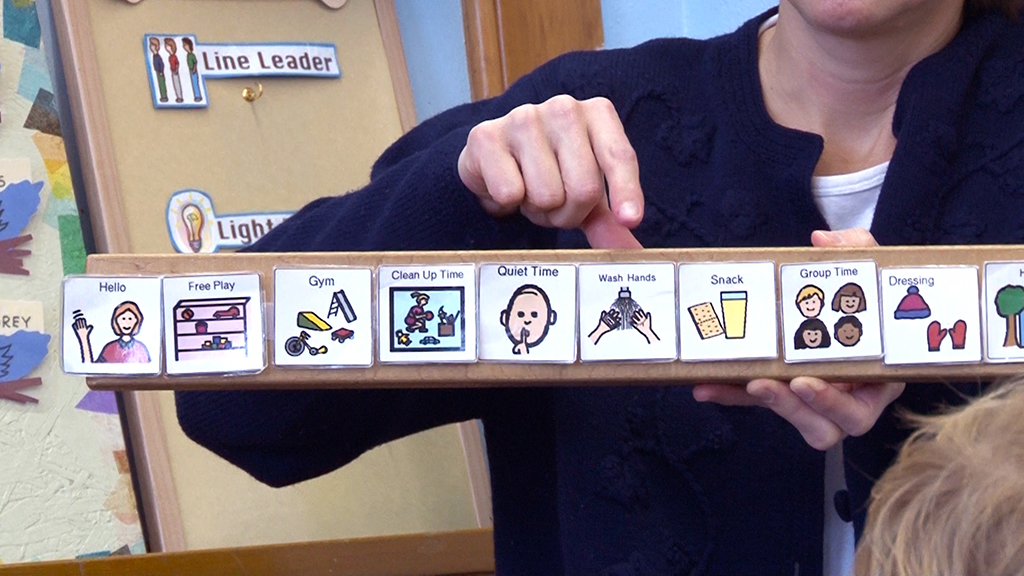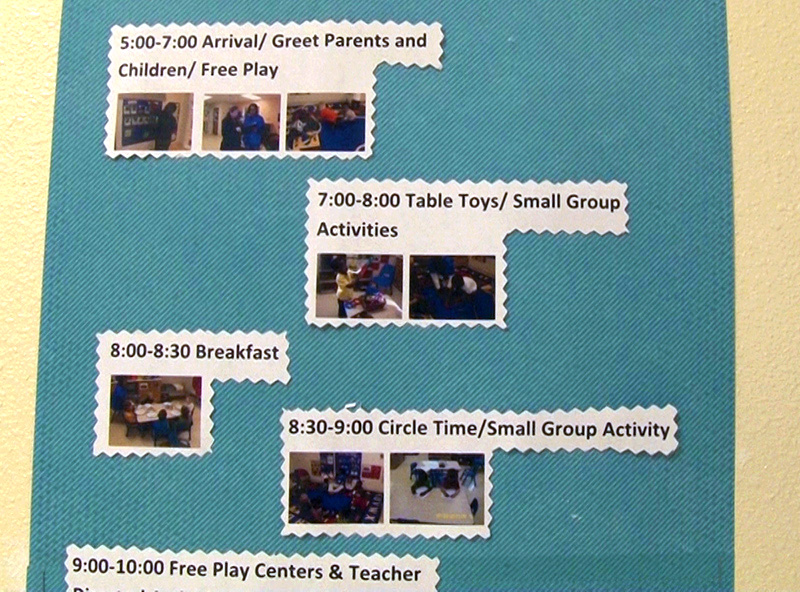- Describe how a consistent daily schedule and routines support positive interactions among children and providers.
- Describe how caring for a mixed-age group of children may affect the environment.
- Reflect on the current family child care environment and ways to build relationships with children and families using positive child-guidance strategies.
Learn
Know
The Importance of the Environment in Family Child Care Settings
Have you ever been in a situation where you were not in control of what was happening in the environment (e.g., waiting for a train to take you to an important event and the train is late)?
Have you ever been in a situation where you have no idea what the schedule will be (e.g., attending a meeting with no agenda, timeline, or end time provided)?
How did you feel in those situations? Perhaps you felt powerless, scared, nervous, or frustrated. When you think about your own emotions and feelings in those situations then you may understand how children could feel if they have no control within their daily environment or have no idea about what comes next in their daily schedule.
Most adults in stressful situations are able to explain their feelings and express their needs:
Children may not be able to use language to express their needs or ask questions in situations where they feel vulnerable and out of control. Children are just learning new words and how to express their emotions. They may communicate their fears and sense of frustration through challenging behavior (e.g., whining, crying, throwing toys, stomping their feet, slamming a door, hitting).
All of us do better emotionally when we know what to expect and when we have a sense of control over what happens in our daily life. In child care, we rely on the environment to help us guide children’s sense of safety, attachment, and security. The environment is critically important to the success of a family child care setting. The more that adults pay attention to the physical and emotional environment and how children interact with the environment, the less likely children are to engage in challenging behavior.
Routines and Schedules
Parents and children need to know the family child care’s routines and daily schedule. It is important that you and the children’s parents have a clear understanding of the daily schedule and expectations for the various age groups you serve. Some family child care programs provide a daily schedule in a parent handbook or posted near the entrance or on the website.
Below are two examples of picture schedules that children can refer to each day to know what comes next and to anticipate daily activities.


Display a word and picture schedule so that children know what is happening during the day. Preschoolers and school-age children may enjoy helping you create this schedule. Post it where they can see it. Following the schedule and providing consistent responsive care will support children’s social and emotional development. When children know what is coming next and how routines are organized, they feel connected to you and other children. They feel secure in knowing what comes next during their day. Refer to the word and picture schedule throughout the day.
Building Relationships With Families: Communicating About Positive Child Guidance Techniques
As a family child care provider, it is important to express and clarify your guidance policies in a written family handbook. Included in the family handbook should be:
- Beliefs about children’s social-emotional development and how positive child-guidance practices support children’s optimal social-emotional development
- Information about developmentally and individually supportive child-guidance practices and resources
- The practices you rely on that support the development of children’s empathy, kindness, and acceptance of all individuals regardless of background, language, or abilities
- Information about the best time for families to contact you if they have any questions or concerns about your child-guidance practices
There may be times when families need information and resources to help them cope with particular stages of development. Many first-time parents are unsure of how to address challenging behavior and may want to meet with you to discuss child-guidance practices.
Your interactions model for parents how to speak to and address children when they engage in mistaken behavior. It is likely that families observe you and how you interact with them and their children during pickup and drop-off times. You build trust with families by genuinely greeting them each day (e.g., using a positive tone, body language, gestures) and showing them that you take personal responsibility for the safety and security of their children. You also build relationships with families when you comment about the warm relationships parents have with their children. As you get to know individual families, you may feel comfortable commenting to a parent about their own use of positive guidance practices when you see them interacting with their child.
There may be times when you will encounter families who have different beliefs and values than you about child guidance. It is always important to respectfully listen to families and learn what they value and try to address their concerns. It is also important that you remain true to your values and explain to parents that you will use positive child guidance and rely on teaching children appropriate behavior through supportive relationship-building methods.
As a family child care provider, your mission every day is to create an encouraging environment that builds relationships and contributes to the safety and security of all the children in your care.
The Role of the Family Child Care Environment in Positive Guidance
As you have learned in this lesson, a family child provider can use the environment (e.g., routines, schedules, and interesting planned activities) to support positive child guidance and minimize challenging behavior. Taking time to reflect on what is going well and what may not be going so well can help you understand what children are communicating through their behavior. Reflecting on your daily communication with families is also important to understanding what children may be experiencing at home or in the community.
Reflect on these examples:
- If children cry and resist coming indoors after playing outside, think about what activity they might like and plan that activity for the time when they first come inside. For example: “In two minutes we will go indoors. After we go inside, it will be time to turn on the music and sing songs together.”
- A toddler resists leaving the child care setting with his father because his dad always picks him up during afternoon snack time. Plan what you might say when you talk with his father about your daily schedule. How might you suggest an alternative pick up time? Or how might you work with the family to make this transition time easier?
- Three preschoolers are learning how to ride tricycles, but you only have one tricycle. The children fight over whose turn it is to ride the tricycle. How might you explain to them that when one child is done, it will be another child’s turn? How can you arrange a visual reminder about when a child will have a turn?
- A child becomes overwhelmed by noise and feels anxious. How might you arrange for a safe, secure, quiet area where she can de-stress?
See
Watch the following video for examples of positive environmental supports. Notice how the family child care provider uses the environment to support children’s positive social and emotional development.
Positive Environmental Supports
Do
Positive Guidance in Mixed-Age Care Environments
When we think about child guidance in the family child care setting, we acknowledge that there are benefits and challenges to serving mixed-age groups.
Some benefits:
School-age children can handle more independence — you can provide them with more choices and give them more autonomy about following routines and rules.
Example: “Carlos and Jana you may choose either a banana or an apple for afternoon snack today.”
School-age children can model using words to express their feelings and emotions.
Example: “I’m sad that Aliya won’t play this game with me.”
Preschool-age children can assist toddlers during difficult transitions.
Example: “Come play in the sandbox with me and wait for your mommy to come.”
In addition to the examples above, infants and toddlers can observe and learn the positive interactions and language that older children and adults are using. You can use positive guidance techniques to create a caring community of learners and promote a family atmosphere when you serve children of different age groups.
Along with the benefits, there are also challenges to mixed-age grouping regarding behavior. Planning and thinking ahead about ways to support each child may be helpful to you when caring for a range of age levels. You should:
- Keep in mind that guidance strategies change depending on a child’s developmental milestones. Ask families to tell you about any changes in family structures or events that may have an impact on their child’s behavior.
- Keep expectations realistic for each age range; each child is unique and develops at his or her own pace.
- Following an infant’s feeding, sleeping, and diapering schedules can sometimes be difficult when you are also caring for toddlers. Think ahead and plan for what you might do to minimize wait times for busy toddlers while attending to infants’ needs.
- Younger children may knock over or disrupt ongoing projects created by older children. Look carefully at your physical environment and how you might design a separate area for older children while still being able to safely observe all the children.
- Teach younger children to respect older children’s books, homework, projects, etc.
- Teach preschool and older children that the younger or newer members of your child care program are still learning the rules and are finding appropriate ways to express their feelings and needs. Encourage them to be models of how to safely and kindly work within your program.
Creating a welcoming and safe environment with carefully planned routines and engaging activities goes a long way toward keeping challenging behaviors from occurring. Your positive attitude and warm interactions create an encouraging environment that seeks to build relationships and contribute to the safety and security of all the children in your care.
Explore
Observation is not a passive activity. Instead, observation requires a person to actively perceive and recognize important aspects of their environment. By carefully observing, you can often discover parts of your environment or program schedule that can be improved to better support positive behavior and interactions in your program. It can be useful to ask a trainer, coach, or family child care administrator to observe your program environment and give you feedback on how your environment functions. Use the Observing Environments activity and work with your trainer, coach, or family child care administrator to reflect on the appropriateness of your program spaces.
Apply
Take a moment to review your current daily schedule to determine if any parts of it need adjustment. When children display challenging behavior, remember to review your schedule as their behavior may be your cue that part of the schedule isn't working optimally. Also remember to review your schedule when children join or leave your program. Use The Daily Schedule tool to reflect on the transitions and routines in your program. How do you balance active vs. quiet activities throughout the day?
Glossary
Demonstrate
Gartrell, D. (2012). Education for a civil society: How guidance teaches young children democratic life skills. National Association for the Education of Young Children (NAEYC).
Merrill, S. (2020, September 11). Trauma is 'written into our bodies'-but educators can help. Edutopia. https://www.edutopia.org/article/trauma-written-our-bodies-educators-can-help
National Center for Quality After School Programs. http://www.sedl.org/afterschool/resources/curriculum.html
Dodge, D. T., Rudick, S., & Colker, L. J. (2009). The creative curriculum for family child care (2nd ed.). Teaching Strategies, Inc.


